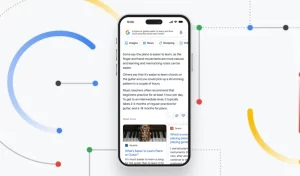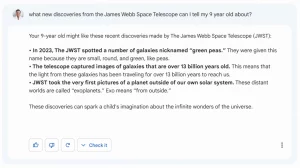
Google has released a chatbot with artificial intelligence named Bard.
Bard is an experimental conversational AI service powered by Language Model for Dialogue Applications, according to Google CEO Sundar Pichai in a blog post (LaMDA).
Before becoming more broadly accessible to the general public in the upcoming weeks, Pichai stated that Bard will be accessible to “trusted testers.”
“Bard aims to unite the depth of human knowledge with the strength, humor, and inventiveness of our massive language models. It uses data from the internet to deliver new, excellent responses, according to Pichai.
“Bard can be an outlet for creativity and a launchpad for curiosity, letting you to explain new discoveries from NASA’s James Webb Space Telescope to a 9-year-old or learn more about the top strikers in football right now, then get workouts to improve your talents,” says Bard.
Bard, which is rumored to be a competitor of Microsoft-sponsored AI ChatGPT, plans to integrate its most recent AI developments into a number of its applications, starting with Search.
Pichai continued, “Soon, you’ll see AI-powered features in Search that condense complex information and multiple perspectives into easily digestible formats, so you can quickly understand the big picture and learn more from the web: whether that’s seeking out additional perspectives, like blogs from people who play both the piano and the guitar, or going deeper on a related topic, like steps to get started as a beginner.
The business, however, stated that further testing will be required in addition to scaling up more consumers to “provide for more feedback.”
To ensure that Bard’s responses satisfy a high standard for quality, safety, and groundedness in real-world knowledge, the business stated it would integrate external feedback with its own internal testing.
Bard, Google’s response to OpenAI’s ChatGPT, is now being tested. Additionally, Google Search’s AI-powered features have been given their first public preview.
Sundar Pichai, CEO of Google, today announced the soft launch of Bard to a group of “trusted testers” and provided several examples to highlight what this early experimental edition looks like.
Because Pichai highlighted it on the most recent Google earnings call, we were aware of this development.
What Google’s AI features will look like in Search
Since everyone is interested in seeing how ChatGPT-style AI will work in Google Search, let’s start there.
Take a look at the image that Google gave. It demonstrates how Google Search utilizes AI to react to lengthy searches with a lengthy response produced by AI:

You can see how Google might soon include AI-generated responses right into Google Search from this screenshot.
Pichai penned:
“Soon, you’ll see AI-powered Search features that condense complex information and multiple perspectives into easily digestible formats, so you can quickly understand the big picture and learn more from the web: whether that’s seeking out additional perspectives, like blogs from people who play both the piano and the guitar, or going deeper on a related topic, like steps to get started as a beginner.”
Furthermore, Bard is distinct from Google search. The AI-powered capabilities that will soon be available on Google Search are highlighted in the screenshot above.
What Bard looks like
Another Google screenshot demonstrating how Bard, a stand-alone ChatGPT-like service, might answer a query

Can I share any James Webb Space Telescope discoveries with my 9-year-old?
In this instance, Bard is imparting to a 9-year-old new information obtained by NASA’s James Webb Space Telescope.
As you can see, there is no solitary correct response to this query.
What is Google Bard?
According to Google, Bard is an experimental LaMDA-powered conversational AI service (Language Model for Dialogue Applications).
At the keynote address for the 2021 Google I/O, LaMDA was introduced as Google’s upcoming language and conversational capabilities. These user-generated replies are currently being produced using it.
LaMDA’s lightweight model, which takes “much less computational resources,” powers Bard, according to Google. According to Google, doing so will enable them to scale to more consumers and receive more feedback.
Pichai also wrote:
“Bard aims to unite the depth of human knowledge with the strength, humor, and inventiveness of our massive language models. It uses data from the internet to deliver original, excellent answers. Bard can serve as a creative release and a springboard for curiosity, enabling you to teach a 9-year-old about recent discoveries made by NASA’s James Webb Space Telescope or learn more about the top football strikers of the moment before receiving drills to hone your talents.
Bard is experimental
Google emphasized that Bard is experimental and they are excited for this “phase of testing to help us continue to learn and improve Bard’s quality and speed.”
Who are trusted testers?
Google informed us that they do not serve as Search Quality Raters. Instead, they are a varied group of non-Google individuals from various racial, ethnic, and geographic backgrounds.
These testers evaluate Google’s products in order to inform Google’s development and better understand how actual people would utilize them. Google claimed that this testing is provided in collaboration with a third-party supplier.
It’s unclear how either of us can try out Bard before it goes mainstream.
Attribution and citations
I questioned Google regarding how it intended to give credit and/or citations for its responses, whether from Bard or in search results. At the time this was published, Google had no quick response.
Why we care
It’s intriguing to observe how AI and search businesses are including solutions to questions that are human-like in nature. To now, Google’s Bard appears to be following a strategy close to ChatGPT, but it is still early and I anticipate the user experience and interfaces will change quickly.
Another intriguing subject is how Google may manage attribution and citation, particularly in search. For years, Google has employed AI to create its information panels; as a result, Google does not always provide credit for all knowledge panels.
What about Microsoft and ChatGPT?
Microsoft has made significant investments in OpenAI, the company behind ChatGPT. According to rumors, Microsoft will soon integrate GPT-4 into Bing search in some fashion. Additionally, early screenshots of Bing’s UI with ChatGPT-style search integration have already been released.
After OpenAI’s ChatGPT’s meteoric rise to prominence, many businesses, particularly those in the search industry, are seriously considering these technologies.
Five features of Google’s Bard you should know
Technology company, Google has said it is planning to release its own conversational Artificial Intelligence service called Bard.
The conversational AI service is strengthened by Language Model for Dialogue Applications which seeks to provide better services for users and developers alike.
Bard is expected to compete with Open AI’s ChatGPT which has become an international trend since its launch in December 2022.
It was reported Bard is now available to trusted testers ahead of making it more generally available to the public after the company released a search trends report last week, which showed that more people across the globe have an interest in AI.
Below are five attributes of Bard you need know
1. Nonstop rivalry against ChatGPT
Google, a company renowned for its innovation in the technological sector, will immediately compete with ChatGPT through Bard to be directed to various encounters.
The technology company is under pressure to introduce Bard as competition.
As a result of ChatGPT’s expansion, Google fell short of its income projections for 2022 as ad revenue plummeted sharply by 3.6%.
2. Stronger channel of information
The tech business described Bard as a “conversational AI service” that combines the strength, intellect, and depth of the world’s information.
It claimed that the distinctiveness of its substantial language models will also aid in supplying responses to queries.
The fact that Bard can provide information on recent occurrences whereas ChatGPT cannot provide information on events occurring after 2021 is one of the main contrasts between the two systems.
3. Created for developers
Google’s CEO, Sundar Pichai, announced that the company would start making preparations to enlist the help of independent programmers, content producers, and businesses to use its Generative language API to develop cutting-edge services.
LaMDA is anticipated to power Bard when it adds further models.
Soon, Google designs for developers will be made available, including Utility AI, Image generation, and Music generation.
4. Ability to process complex information
Bard will be integrated with Google Chrome to transform complex data and different viewpoints into digestible formats, enabling you to rapidly grasp the larger picture and gain more knowledge from the web.
Google CEO Sundar Pichai stated, “Soon, you’ll see AI-powered features in Search that process complex information and multiple perspectives into easy-to-digest formats, so you can quickly understand the big picture and learn more from the web: whether that’s seeking out additional perspectives, like blogs from people who play both the piano and the guitar, or going deeper on a related topic, like steps to get started as a beginner.
5. Doorway to internet
Since ChatGPT began, AI has seen extremely high demand, which has led to a number of outages.
Pichai said, however, that Bard will manage a scaled-down and lightweight version of the Language Model for Dialogue Applications.
He declared, “We’ll combine external feedback with our internal testing to ensure Bard’s solutions satisfy a high bar for quality, safety, and groundedness in actual data. We’re eager to use this testing period to continue learning and enhancing Bard’s performance.